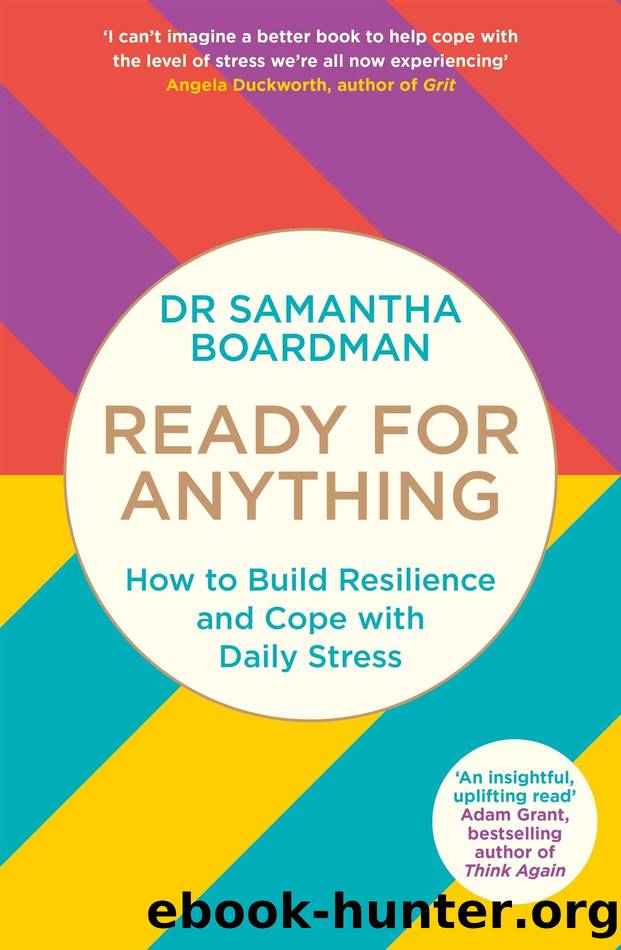Ready for Anything by Samantha Boardman

Author:Samantha Boardman [Boardman, Dr Samantha]
Language: eng
Format: epub
ISBN: 9780241292242
Publisher: Penguin Books Ltd
Published: 2020-05-07T00:00:00+00:00
Expand Your Vocabulary
Understanding why he had so assiduously avoided discomfort was an interesting insight for Mike, but he cared more about learning how to become more comfortable with feeling uncomfortable. Expanding his emotional vocabulary was a good place to start. When something was bothering him, I pressed him to be more precise about what he was feeling, instead of habitually rationalizing or avoiding. Labeling his emotions helped him feel more empowered to deal with them. For instance, during one of our next sessions, Mike mentioned his ex-girlfriend had sent him a text to ask if he could leave the pair of sneakers she had left at his house with her super so she could pick them up.
âItâs just annoying,â he remarked.
I encouraged him to be more specific. âThe text stings because it feels so final,â he explained. âHaving those sneakers in the closet made me feel connected to her. They always gave me a little bit of hope that we would get back together. I have been hanging on to this fantasy that we would meet up for coffee so I could return the sneakers. Then we would have this great conversation, and I would tell her that Iâm in therapy and working on my issues. I hoped she would agree to give our relationship another chance. This text extinguishes all of that.â By putting his feelings into words, he was able to articulate precisely what he hoped for. It also gave him the courage to text her to suggest they meet for coffee.
The next time you find yourself feeling down, be as specific about the reasons for your state of mind as possible. Do you feel frustrated? Disheartened? Despondent? Exasperated? Instead of resigning yourself to a generalized negative mood, try to identify your emotions. Distressing feelings are less likely to dominate your attention and dictate how you behave if you can label them.6
Pinpointing what it is thatâs upsetting you empowers you to seek a solution and to tailor a response. For example, recognizing that you are feeling dismissed by a colleague might prompt you to speak to the manager or perhaps go for a walk outside. Simply feeling âbadâ about work doesnât provide you with any useful or actionable information, but hovers over you like a cloud and can easily rain on other aspects of your life. Nebulous feelings might manifest later as irritation with your partner or impatience with your child.7 Identifying what upset you and putting a name on the emotion is like sealing off a crime scene with police tape. A clearly demarcated problem is less likely to become an emotional boomerang.
Weâre taught to consider emotions and moods as binary: youâre happy or sad, calm or anxious. Ask your friends, âHow was your day?â or âHow are you?â and theyâll probably answer along positive or negative lines. There is value in recognizing that far more nuance exists in emotional states than we often allow for, and that negative and positive emotions can coexist. Evidence suggests that
Download
This site does not store any files on its server. We only index and link to content provided by other sites. Please contact the content providers to delete copyright contents if any and email us, we'll remove relevant links or contents immediately.
Spare by Prince Harry The Duke of Sussex(5132)
Machine Learning at Scale with H2O by Gregory Keys | David Whiting(4257)
Fairy Tale by Stephen King(3305)
Will by Will Smith(2872)
Hooked: A Dark, Contemporary Romance (Never After Series) by Emily McIntire(2527)
The Bullet Journal Method by Ryder Carroll(2524)
Rationality by Steven Pinker(2325)
Can't Hurt Me: Master Your Mind and Defy the Odds - Clean Edition by David Goggins(2267)
It Starts With Us (It Ends with Us #2) by Colleen Hoover(2252)
Friends, Lovers, and the Big Terrible Thing by Matthew Perry(2178)
The Becoming by Nora Roberts(2147)
Love on the Brain by Ali Hazelwood(2020)
HBR's 10 Must Reads 2022 by Harvard Business Review(1820)
The Strength In Our Scars by Bianca Sparacino(1817)
A Short History of War by Jeremy Black(1815)
Leviathan Falls (The Expanse Book 9) by James S. A. Corey(1694)
A Game of Thrones (The Illustrated Edition) by George R. R. Martin(1657)
515945210 by Unknown(1640)
Bewilderment by Richard Powers(1574)
